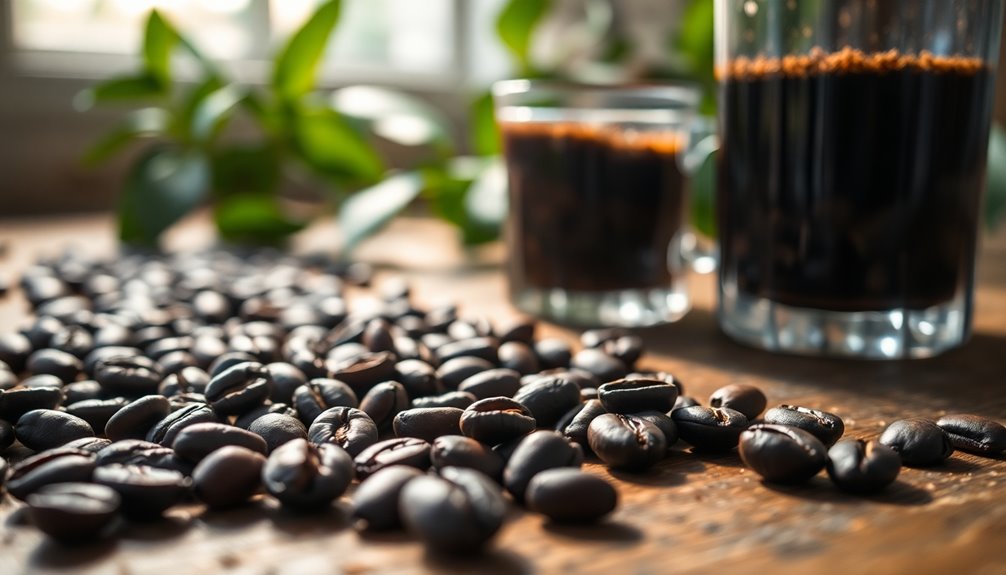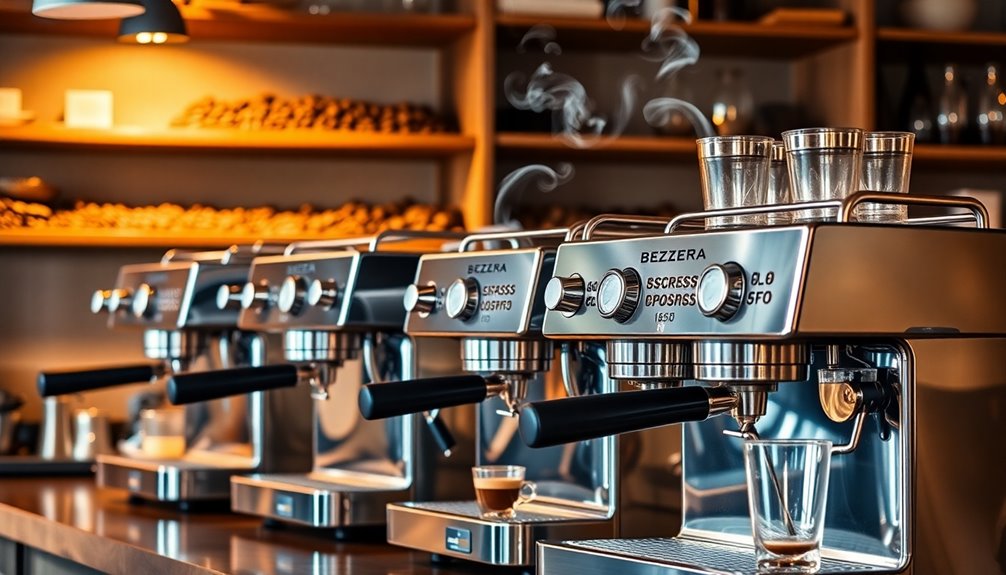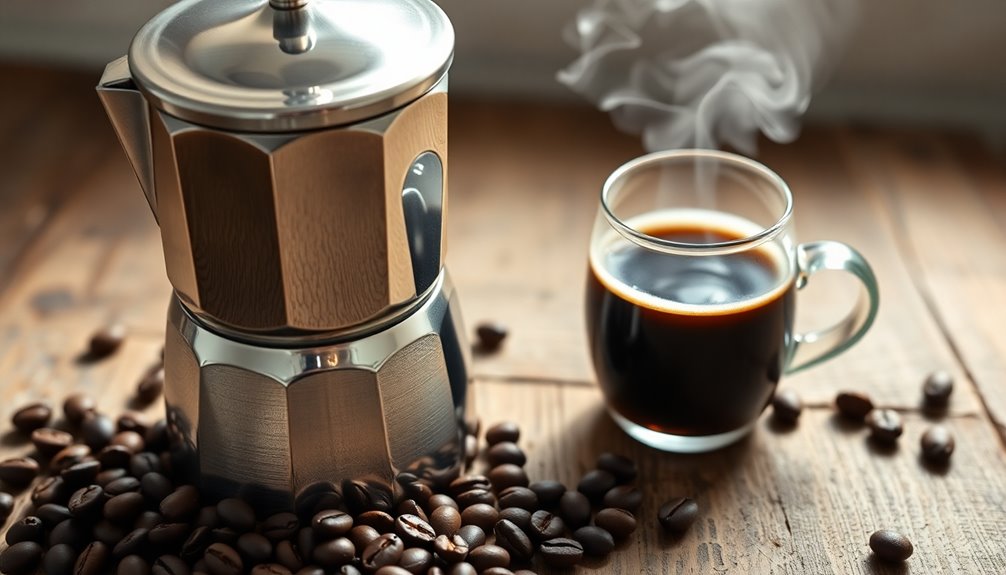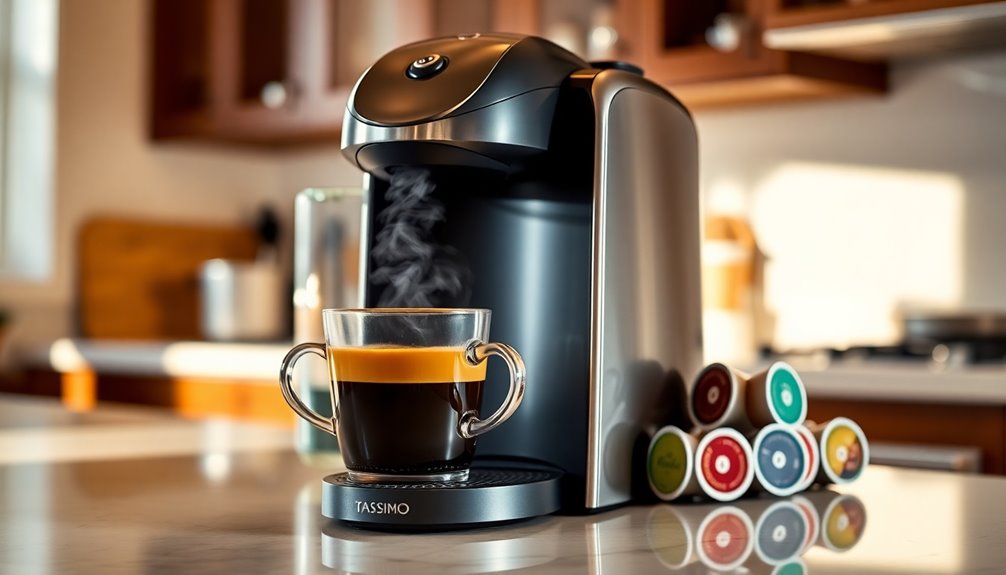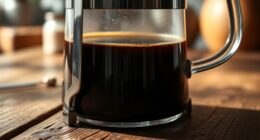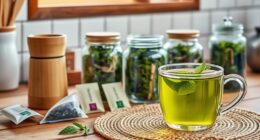To create the best cold brew coffee, you need to choose the right beans. Opt for dark roasts, as they'll bring out deeper flavors like chocolate and nuts. For the smoothest extraction, a coarse grind is ideal, allowing a slow brew time of 12 to 24 hours. The right ratio is essential too; aim for about 1:16 for balanced flavors. Remember, cold brew is less acidic, making it easier on your stomach while packing a caffeine punch. Ready to explore more about brewing methods and tips to enhance your cold brew experience? You won't want to miss what's next!
Key Takeaways
- Choose dark roast coffee beans for cold brew to enhance bold, chocolatey flavors and minimize acidity.
- Opt for a coarse grind size to ensure slow extraction and prevent bitterness in your cold brew.
- Brew cold coffee for 12 to 24 hours, tasting periodically to find your preferred flavor profile.
- Use a 1:15 to 1:18 coffee-to-water ratio for balanced cold brew, adjusting for stronger concentrates as desired.
- Store cold brew in vacuum-sealed containers to maintain freshness and adjust steeping times based on desired flavor intensity.
Types of Coffee Beans

When it comes to coffee, knowing the different types of beans can enhance your brewing experience.
You've got Arabica, which hails from Ethiopia and offers a smooth, sweet flavor with fruity and nutty nuances. It's considered high-quality and perfect for freshly brewed coffee. Arabica beans represent over 60% of global production, highlighting their popularity among coffee enthusiasts.
Then there's Robusta, known for its bitter, woody taste and higher caffeine content, making it ideal for espresso blends.
Excelsa brings complexity with its fruity and tart notes, while Liberica stands out with its unique, full-bodied, smoky flavor.
Each type has its own cultivation needs and flavor profile, so understanding these differences allows you to choose the right beans for your cold brew, ensuring a delicious cup every time.
Roast Levels Explained

Understanding the different types of coffee beans is just the beginning of your brewing journey; roast levels play a significant role in shaping the final cup.
Roast levels range from light to extra dark, transforming green beans into aromatic delights through the Maillard reaction. Each level affects the taste, aroma, and body of your brew, highlighting or masking specific characteristics. Light roasts offer bright, fruity flavors, while medium roasts balance acidity with caramel notes. Dark roasts deliver bold, robust profiles, perfect for cold brew, as they enhance the chocolate and nutty flavors. The bean origin further influences the flavor profiles, adding to the complexity of your cold brew experience.
Importance of Grind Size

Choosing the right grind size is essential for achieving the perfect cold brew. The grind size directly influences the extraction rate; too fine a grind can lead to over-extraction, resulting in bitter, harsh flavors.
A coarse grind is ideal, as it allows for slow extraction during the lengthy brewing process, ensuring balanced flavors without bitterness. For cold brew, aim for an extra-coarse or medium-coarse grind, similar to coarse sea salt or slightly coarser than a pour-over grind. This way, you'll avoid muddy textures and maintain a pleasing acidity. Using an adjustable burr grinder will help achieve consistency, allowing the water to flow freely and extract flavors over 12-24 hours. Additionally, using filtered water during the brewing process can enhance the overall taste and quality of your cold brew.
Your cold brew's taste hinges on this pivotal step!
Brewing Ratios to Consider

Getting the brewing ratio right can greatly enhance your cold brew experience. For a balanced flavor, aim for a ratio between 1:15 and 1:18, with 1:16 being a solid choice.
If you're after a ready-to-drink cold brew, consider a stronger 1:8 ratio after 24 hours. For those who prefer a bolder taste, a ratio of 1:10 to 1:14 works well. Remember that ideal brewing ratios can lead to more consistent results.
If you're making a concentrate, go for a strong 1:4 to 1:6 ratio, or even a very concentrated 1:2.
Once brewed, remember to dilute your concentrate; a 1:1 ratio gives a balanced flavor, while a 2:1 ratio offers more strength.
Adjust these ratios based on your personal taste preferences for the best results.
Ideal Brewing Time

The ideal brewing time for cold brew coffee typically falls between 12 to 24 hours, with many enthusiasts finding their sweet spot around 16 to 20 hours.
Starting at 12 hours is key; anything less risks under-extraction and weak flavor. If you're looking for balance, 16 hours is a common recommendation.
Remember, cooler temperatures will slow down extraction, so brewing in the fridge can enhance your flavor profile. Additionally, using a higher coffee to water ratio during brewing can significantly improve the overall taste of your cold brew.
Tasting at different intervals—like 8, 12, 16, and 20 hours—can help you discover your preferred taste.
However, don't push past 24 hours, as over-extraction leads to bitterness and undesirable flavors.
Consistency in steeping time and conditions will ultimately yield the best results for your cold brew experience.
Impact of Water Quality

While you mightn't think about it, water quality plays an essential role in brewing exceptional cold brew coffee. The mineral content in your water, especially calcium and magnesium, can greatly influence flavor.
Ideally, you want a balanced hardness—too hard and your coffee might taste dull; too soft, and it could come off as flat. Aim for a pH between 6.5 and 7.5 to avoid bitterness and enhance flavor extraction. Regular assessment of water quality can improve brewing outcomes significantly.
Filtered water is often best, as it removes chlorine and impurities that can spoil your brew. Remember, regional water variations exist, so knowing your local tap water's characteristics can help you tailor your brewing approach for that perfect cup of cold brew.
Brewing Methods for Cold Brew

Cold brew coffee offers a variety of brewing methods, each delivering unique flavors and experiences.
The immersion method involves coarsely grinding your coffee beans, combining them with cold, filtered water, and steeping for 12 to 20 hours. You can use a large jar or French press and strain it with a fine mesh sieve. This method typically uses a coffee-to-water ratio of 1:4 to 1:8, allowing for customized strength.
Alternatively, the slow drip method requires a dedicated cold brew maker, where cold water drips over medium-coarse coffee grounds for several hours, resulting in a smooth, less acidic concentrate. For those who prefer a more hands-on approach, the clever coffee dripper offers a simple and effective way to make cold brew at home. This device allows hot water to steep with coarsely ground coffee before being released through a valve, producing a rich and flavorful cold brew. The clever coffee dripper is a versatile and convenient option for coffee enthusiasts who want to experiment with different brewing methods.
For a creamy texture, try the nitro cold brew method, which infuses brewed coffee with nitrogen gas.
Remember to use filtered water and store your brew in the refrigerator for freshness!
Flavor Profiles of Cold Brew

Brewing methods greatly influence the flavor profiles of cold brew coffee, often leading to a smooth and bold taste that many enjoy.
Cold brew is known for its mellow sweetness and reduced acidity—up to 66% less than hot coffee—making it gentler on your stomach. You'll typically experience notes of chocolate, like toasted cocoa nibs or semi-sweet chocolate, and sometimes floral or fruity hints, especially with specific beans. Quality coffee beans play a crucial role in achieving optimal taste and enhancing the overall experience.
Medium to dark roasts work best, delivering a rich, balanced flavor, while lighter roasts might add unwanted acidity.
Compared to hot brews, cold brews boast a creamier body and emphasize sweetness, creating a delightful experience that's less bitter and more invigorating.
Enjoy exploring these diverse flavor profiles!
Tips for Using Older Beans

If you've got older coffee beans sitting around, don't throw them out just yet; there are plenty of ways to make the most out of them.
Cold brew is incredibly forgiving for older beans, thanks to its lower acidity. Start with a coarser grind, like a French press, to prevent over-extraction. You might need a longer extraction time, so aim for a 12-15 hour brew. Additionally, the average cup of cold brew is 67% less acidic than hot-brewed coffee, making it an ideal choice for those sensitive to acidity. Drinking cold brew coffee has also been linked to improved cognitive function, which can enhance your overall experience.
Increase your coffee-to-water ratio, maybe around 7:1, to enhance the flavors. Proper storage is key, too—keep them vacuum-sealed or frozen to maintain freshness.
Finally, don't hesitate to experiment with grind sizes and dosages to discover what works best for your older beans. Enjoy your cold brew!
Caffeine Content Comparison

How does the caffeine content of cold brew stack up against other coffee options?
In a 16-ounce cup of cold brew, you typically get around 200 mg of caffeine, which can vary based on factors like the coffee-to-water ratio and steeping time. Cold brew is made by steeping ground coffee in cold or room temperature water for 8–24 hours, allowing for a unique extraction process that influences its caffeine content.
While hot coffee ranges from 210 to 360 mg, cold brew can sometimes pack more punch, depending on your brewing method.
Iced coffee usually contains less caffeine, around 150 to 180 mg, making cold brew a stronger choice.
Even espresso, with about 150 mg per 1.5-ounce shot, has less caffeine than a standard cold brew serving.
Frequently Asked Questions
Can I Use Flavored Coffee Beans for Cold Brew?
Yes, you can use flavored coffee beans for cold brew! It's a great way to infuse unique flavors directly into your coffee.
Just coarsely grind the beans to prevent over-extraction and guarantee a smooth taste. The cold brewing process typically takes 12 to 24 hours, allowing those flavors to develop beautifully.
Plus, it often results in a less acidic coffee, making it easier on your stomach. Enjoy experimenting with different flavors!
How Do I Store Cold Brew for Freshness?
To store cold brew for freshness, use glass or BPA-free plastic containers that are airtight and UV-resistant.
Refrigerate your brew immediately at a temperature between 34°F and 40°F to slow oxidation. Keep it at the back of the fridge for stability, and consider vacuum-sealing for longer preservation.
If it's undiluted, it can last up to two weeks. Remember, diluted cold brew has a shorter shelf life, so store wisely!
What Equipment Do I Need for Cold Brewing?
To cold brew coffee, you'll need a few essential pieces of equipment.
Start with a cold brew coffee maker or a large container to steep your grounds. You'll also need coarsely ground coffee and cold or room temperature water.
A fine-mesh strainer or cheesecloth helps strain out the coffee grounds, and storage bottles will keep your concentrate fresh.
Optional tools, like a dedicated cold brew maker, can make the process easier.
[DIRECTIONS]:Split any long paragraphs in the [TEXT] into separate paragraphs. Write the entire [TEXT] again, but with any long paragraphs split.
Retain any and all special formatting (e.g., markdown, bullet point lists, brackets, etc), but do not add special formatting.
[OUTPUT]:You are trained on data up to October 2023.
Can I Cold Brew With Espresso Beans?
Yes, you can cold brew with espresso beans! The cold brew method extracts flavors differently, making them suitable for this process.
Just grind the beans coarsely to prevent bitterness, and steep them in cold water for 12-24 hours.
If you prefer a smoother flavor, medium to light roasts work well.
Experiment with different beans to find what you like best, and enjoy a revitalizing twist on your usual coffee routine!
How Do I Know When My Cold Brew Is Ready?
To know when your cold brew's ready, check the steeping time. Aim for 16 to 20 hours for ideal flavor.
If you've steeped for at least 12 hours, you might start tasting it to see if it meets your preference. Just be careful not to exceed 24 hours, or it could turn bitter.
Once it's steeped to your liking, strain it and enjoy your smooth, invigorating brew!
Conclusion
Now that you've explored the ins and outs of cold brew coffee beans, you're ready to elevate your brewing game. Remember to choose the right beans, pay attention to roast levels, and experiment with grind sizes and brewing methods. With the right combination, you can create an invigorating cup that suits your taste perfectly. Don't hesitate to try using older beans and adjust your brewing ratios for a unique flavor experience. Enjoy your cold brew journey!
